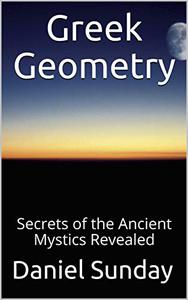
Daniel Sunday PhD, "Greek Geometry: Secrets of the Ancient Mystics Revealed"
English | 2021 | ASIN: B08T4884D5, B08T6SC4DP | EPUB | pages: 137 | 1.0 mb
This book describes the evolution of abstract geometric ideas. This is not a packaged summary, but instead a journey of creative discovery that will inspire readers. It highlights the major Greek geometers and their works. Instead of being a chronology of events, this book gives a chronology of people with a sequence of biographies focused on their contributions to geometry. This makes the flow of Greek discoveries between individuals and the evolution of geometry more transparent.
The book begins with the pre-Socratics (including Thales and Pythagoras) who started the millennium of Greek geometry. It then continues with 13 geometers who preceded Euclid (including Hippocrates, Plato, Theaetetus, and Eudoxus) culminating with Euclid and his "Elements of Geometry" encapsulating many of their works.
After Euclid, a new age of geometry began with Archimedes who was followed by 10 geometers (including Apollonius, Ptolemy, and Pappus). At the start of this period, Archimedes discovered the constant pi, new semi-regular polyhedrons, and new methods of integration, including his now-infamous "mechanical method". Also interesting new curves were discovered such as Archimedes' spiral, Nicomedes' conchoid, and Diocles' cissoid. Further, new mathematical masterpieces were written, namely, Apollonius' "Conics", Ptolemy's "Almagest" on astronomy, and Pappus' "Collection". We give detailed descriptions of these works and their main results.
This journey includes the history of many important geometric topics.
* The evolution of the Pythagorean theorem.
* Formulas to generate Pythagorean triples.
* Attempts to solve the classical problems of squaring a circle, trisecting an angle, and doubling a cube.
* Various mechanical "neusis" methods that were used to solve these three classical problems.
* The determination of what is a valid proof.
* The discovery of the conic sections (parabola, hyperbola, and ellipse), and how they were used.
* The evolution of the method of exhaustion, leading to integration techniques.
* The discovery of pi.
* The discovery of exotic curves, including the quadratrix, spiral, conchoid, and cissoid.
* The evolution of spherical geometry, and trigonometry.
* The birth of projective geometry.
* And much more.



